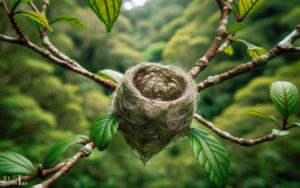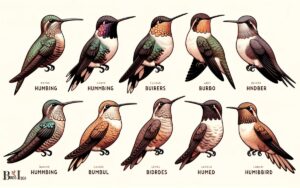What Do Hummingbird Nests Look Like: Size & Shape
Hummingbird nests are tiny and often difficult to find, though they are typically constructed from moss and lichens and camouflaged against tree bark or plants. They are typically cup-shaped, around 2-3 in across and 1-2 in deep.
Though hummingbirds are small and build tiny nests, they are skilled architects and spend days building their homes. Once built, the nests provide safety and security for the hummingbird and its offspring.

Here is a list of what hummingbird nests look like:
- Tiny cup-shaped structure
- Constructed using moss, leaves, feathers, and spider webs
- Average diameter of 2 inches
- Held together with spider silk
- Built in trees, shrubs, or vines close to the ground
- Well camouflaged
- Color ranges from gray to brown
- Typically lined with soft materials such as wool and fur
- Often have a thin layer of lichen
- Interior is often made of spider webs, down, and bits of leaf.
DID YOU KNOW
The average hummingbird nest weighs only 1/8 of an ounce.
Where Do Hummingbirds Build Their Nests?
Hummingbirds build their nests in protected places such as trees and bushes. The nests are made of plant down, lichens and spider webs, and are typically cup shaped and lined with soft materials. They often build nests near well-trafficked areas, such as in gardens, parks, or close to windows.

- Hummingbirds build their nests in protected places on trees, bushes and sometimes even on man-made structures
- Nests are cup shaped and constructed with plant down, lichens, and spider webs
- Common locations that hummingbirds prefer to build nests include gardens, parks, and close to windows
- Nests may be reused or abandoned after the chicks fledge and new nests are often built nearby
- Male and female hummingbirds collaborate to build nests, the female does most of the work.
“Small things can make a big difference.” -Anonymous
What Materials Are Used to Build Hummingbird Nests?

Hummingbirds build their nests using cobwebs, feathers, lichen, moss and spider webs. The nests are also reinforced with plant fibers and lined with soft feathers or animal fur.
The nests are characterized by a small cup shape and built close to the ground. They typically attach their nest to a shrub’s twig, a greenhouse window latch, or an isolated spot on a porch. The construction of the nest may take up to two weeks to complete.
- Cobwebs
- Feathers
- Lichen
- Moss
- Spider webs
- Plant fibers
- Soft feathers
- Animal fur
- Twig from a shrub
- Greenhouse window latch
How Do Hummingbirds Construct Their Nests?
Hummingbirds construct their nests using plant down, spider webs and lichens, secured with a saliva-papier mâché of insects, bark and fresh plant fibers.

Nests are typically cup-shaped and come in an array of sizes depending on the species. The typical size of a hummingbird nest is 2.5 cm in height and 7.5 cm in width. Common nest building locations are trees, shrubs, vines and other areas with abundant foliage.
- Plant Down: as the base to support the nest
- Spider Threads: to secure the nest
- Lichens: to match with the surrounding environment
- Saliva: to create papier-mâché to hold the nest together
- Insects: as an adhesive to the papier-mâché
- Bark: to reinforce the structure of the nest
- Plant Fibers: to give additional support
- Cup-Shaped: the typical shape of a hummingbird nest
- Height: 2.5 cm tall and 7.5 cm wide
- Locations: trees, shrubs, vines and other areas with plenty of foliage.
How Long Does It Take To Build a Hummingbird Nest?

Building a hummingbird nest typically takes from 1 to 2 weeks. Depending on the size of the nest, materials and intricacies, it can take longer.
The construction of a hummingbird nest is done almost exclusively by the female hummingbird using materials like spider webs and plant fibers.
She carefully shapes the nest out of these materials and lines it with pieces of fur and fabric. Some other materials used in hummingbird nests include bits of soft paper and leaves.
What Is the Purpose of Hummingbird Nests?
The purpose of hummingbird nests is to provide a safe and secure environment to protect and incubate the eggs and young chicks.
Additionally, the nests provide insulation against changes in temperature and protection from potential predators. Here are some of the main advantages of hummingbird nests:
Durable and Lightweight: Hummingbird nests are constructed from feathers, mud, and cobwebs, resulting in a nest that is light and durable unlike other types of birds.
Aerodynamic Design: These nests are designed to have a low profile to help reduce the amount of energy hummingbirds expend during flight.
Temperature Insulation: Chicken-like feathers are used to insulate the nest against temperature changes.
Protection from Predators: The dart-like entrance and high branches on which hummingbird nests are situated deters predators from accessing them.
Structure and Stability: Hummingbird nests have a cup structure to ensure eggs and young remain secure while incubating.
What Are Some Common Mistakes to Avoid Around Hummingbird Nests?

Caring for hummingbird nests requires knowledge and respect for the birds. It is important to avoid common mistakes in order to make sure the nesting process goes smoothly. Here are some of the most common mistakes to avoid around hummingbird nests:
Not offering a safe nesting space: Provide hummingbirds with a safe nesting location, away from harsh weather, predators, and other disturbances.
Leaving the nest unattended: Closely monitoring the nest is important. Observing the birds in their natural environment can provide valuable insight into the nesting process.
Not respecting the birds: Remember to give the birds space and do not get too close to the nest.
Not providing the right food and water: Provide the hummingbirds with a diet of small insects and nectar. Ensure they have access to fresh, unpolluted water.
Not keeping the area free of clutter: Keep the area surrounding the nest clean of debris and other obstacles which can make it difficult for the birds to find food and care for their young.
Interfering with the process: Avoid touching or moving the nest, and try not to scare the birds.
Not installing a guardrail: If the nest is close to the ground, install a guardrail to protect the nest from predators and other dangers.
Not providing adequate support: Make sure the nest is securely attached to a branch, wall, or other structure to avoid accidents.
Do Hummingbirds Reuse Their Nests?
No, Hummingbirds usually do not reuse their nests. Nests are usually only used to raise a single brood of chicks before the parents abandon it.

Typically, the parents build a new nest each breeding season. However, some individuals may reuse their nest if it is still intact or have nested in the same area for several years.
Factors That Affect Whether Hummingbirds Reuse a Nest:
- Age and health of the bird
- Physical condition of the nest
- Availability of suitable nesting material in the same area
- Location of the nest
- Disturbance to the nest when previously occupied
- Weather conditions
- Survival of previous clutch
- Birds may find a better site for the new nest
- Nest may not be available due to predation or vegetation changes
- Human disturbance at the nest site
How Does the Size and Shape of Hummingbird Nests Differ from a Non-Pregnant Hummingbird?
The size and shape of hummingbird nests vary significantly from a non-pregnant hummingbird. A pregnant hummingbird appearance influences the nest construction due to the need for extra space for incubation. Their nests tend to be larger and more enclosed, providing a safe and cozy environment for their soon-to-be fledglings.
FAQ
What do hummingbird nests look like?
Where do hummingbirds build their nests?
How long does it take for hummingbirds to construct their nests?
What materials do hummingbirds use to construct their nests?
How often do hummingbirds rebuild their nests?
Conclusion
It is clear that hummingbird nests are small and meticulously crafted from moss and lichens. They range from 2-3 in across and 1-2 in deep, and are often camouflaged by tree bark or plants for protection. Despite their small size, these nests provide important safety and security for the hummingbird and its offspring.





